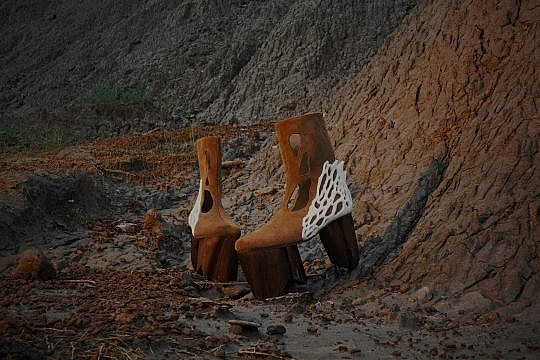
Depop on the up and up
Pre-loved clothing site moves into the billion-dollar league as digital thrifters shun fast fashion
2021 will be remembered for many things – the vaccine roll-out, a new President, world leaders converging on Glasgow for COP26. But it was also a significant year for the slow fashion movement. Can we expect more of the same in 2022?
In many ways, 2021 was the year when slow, sustainable fashion thrived. We bought fewer clothes, we rented more and we embraced pre-loved fashion. Brands from Mulberry to Zara also got in on the eco-conscious act with innovations including the world’s lowest carbon leather bags and party dresses made from recycled carbon emissions. So, will this sustainability trend stick – and if so, what direction will it take? Here are the developments we’ll be watching in the year ahead.
Traceability
The fashion industry is facing increased scrutiny. It’s the target of a new investigation by the UK competition watchdog into “misleading environmental claims” and, under upcoming EU legislation such as the Sustainable Textile Strategy, will come under greater pressure to improve the transparency of its supply chain.
Saying that your products are sustainable is no longer enough – brands will need to be able to back up those claims with real data. Some have already upped their game, including ethical footwear and leather goods brand Nisolo. It launched a ‘sustainability facts label’ late last year that not only includes the environmental impact of how a product is made and transported but also the social impact on the people who make it.
Blockchain technology is also doing its bit, most notably helping a consortium of luxury brands including LVMH, Prada Group and Richemont to communicate information on authenticity, responsible sourcing and sustainability in a secure, digital format. The buyer simply scans a QR code to access an app with the story behind the item, from its raw materials to manufacturing and distribution.
It’s encouraging to see brands giving consumers the information they need to make considered purchases. Transparency and traceability are also a priority for the leather industry, with work underway by the Leather Working Group. We expect to hear more on this important topic in the coming months.
Plastic-free
To meet the demand for (genuinely) sustainable fashion, brands are making changes to how their products are made. This has led to innovation in the materials space, including designing out synthetics, which 60% of fast fashion is made of.
Plastics aren’t only produced using fossil fuels, they also release millions of microplastics into our waterways every time they’re washed, harming marine life. And because they’re non-biodegradable, unlike natural leather, they stick around for hundreds of years.
Some fashion brands are waking up to that fact and are mending their polluting ways. Retailer Boden has ditched its use of (petroleum-based) glitter and sequins “to keep our oceans happy” while Pangaia launched a new activewear collection made from bio-based materials including seaweed. More recently, Patagonia announced a collaboration with Samsung to tackle the shedding of microplastic fibres from its fleece jackets. This will include the creation of a new washing machine that will filter microplastic waste and keep it out of the oceans.
We’ll be watching with interest to see what comes next and hope to see more brands swapping harmful plastics for more natural materials that are kinder to the environment.
Alter, repair, re-wear
The trend for sustainable fashion has also led to a new interest in clothing care and repair. According to WRAP, extending the life of clothes by nine extra months can reduce carbon, water and waste footprints by around 4-10% each. High-end luxury brands such as Hermés and Mulberry have long offered in-house repair services, but more mainstream brands are now catching up. In October, e-tailer Zalando launched a care and repair service. A collaboration with wardrobe app Save your Wardrobe, the new initiative being piloted in Germany puts customers in touch with affordable, locally vetted suppliers. Other notable partnerships include GANNI’s tie-up with Sojo, described as the Deliveroo of fashion repair – think repairs collected and delivered by bike – and Farfetch’s collaboration with The Restory (whose services we already know and recommend for all your leather repairs). Who will be next in the emerging aftercare economy and what other steps will brands take to close the loop on fast fashion? Watch this space.
As we look back at 2021, there’s a common thread. Whether it’s traceability in the supply chain, prolonging the life of clothes or addressing the issue of microplastics waste, the past year has shown the power of partnership and what can be achieved when technology, innovation and bold ambition come together. We hope to see further progress in the year ahead and look forward to demonstrating the role that leather can play in a transparent, plastic-free and sustainable fashion future.

Pre-loved clothing site moves into the billion-dollar league as digital thrifters shun fast fashion

ARKET is a Swedish clothes, accessories and homeware brand with sustainability at its core – the company’s stated mission is ‘to influence positive change in fashion’. But don’t let that make you think it is boring.

London Fashion Week returned with seasoned names and exciting newcomers taking their designs for spring 2022 to the

Kheng Yao, born in Johor, Malaysia, is currently pursuing a bachelor's degree in fashion design in Taiwan. Kheng Yao's work, Tafoni, is inspired by and named after the natural phenomenon of Tafoni rock formations. Tafoni are formed through geological